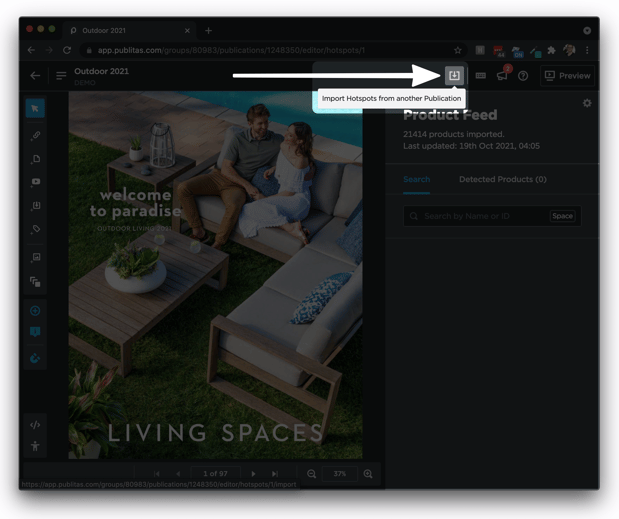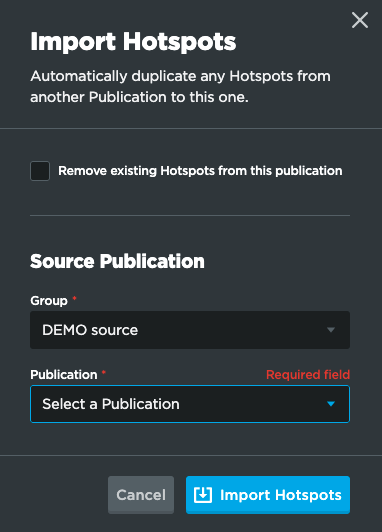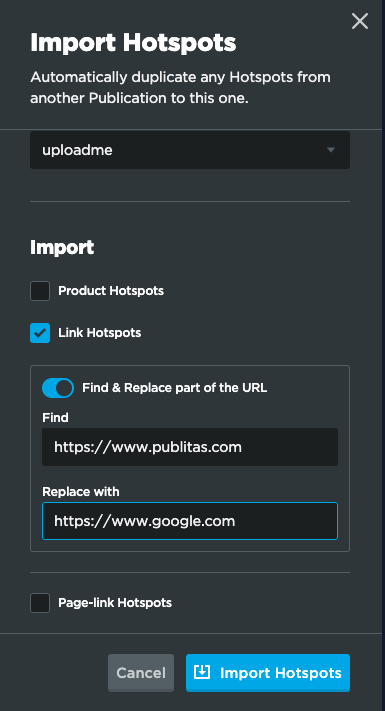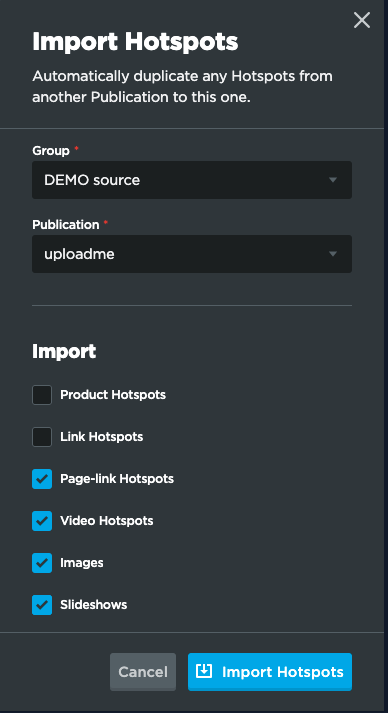Importing hotspots from another publication
Learn how to save valuable time when adding hotspots to publications that come in different versions by exporting them to the other copies of the publication
If you publish your publications in different languages or markets, the editor offers a powerful tool that supports importing hotspots from another publication. This feature automatically tags one publication with hotspots after which you copy and transfer the hotspots to a different version.
If you're using the product feed integration to create product hotspots, the product data will be synced with the feed that is connected to the target publication, updating details like prices and language automatically as well.
In this article:
- Who is this for?
- Using the tool
- Import Product Hotspots
- Import Link Hotspots
- Import Page-link Hotspots, Video Hotspots, Images, or Slideshows
Who is this for?
Enterprise users that:
- Publish multiple versions of the same PDF
- Need all versions of a publication tagged with similar hotspots
The feature works best if all versions are exact copies of each other where the only difference is found in the copy (e.g. language and prices). If the number of pages or the order of the pages is different in your target publication, we recommend to add or reorder the pages after importing all the hotspots (also see Adding or removing individual pages).
Using the tool
Once you have created all the versions of the publication in Publitas and you have completed tagging one of them with hotspots, locate the next version you need to tag in Publitas and open the hotspot editor.
In the upper right corner, you will find the option to import the hotspots from another publication.
Locating the import option:
Click on the button to import the hotspots to get started.
From the Group drop-down, select the publication group in which the tagged publication is located.
Use the Publication drop-down to select the tagged publication.
TIP: If you have changed any existing hotspots in your target publication and are importing the hotspots for a second time, it is recommended to remove the existing hotspots to avoid duplicates. Please be aware that the option will remove all hotspots, not only the hotspot types you select to import.

After this, select the types of hotspots you wish to import will import. For any type of hotspot that you do not wish to import, simply leave the corresponding box unchecked.
Use the following bookmarks to quickly jump to each section on the different hotspot types:
Import Product Hotspots
Select this option when you want to import the product hotspots from your tagged publication.
If you select to copy all the products and the process involves two different feeds, remember that the products not existing in the feed connected to the destination publication will include the original content from the tagged (source) publication. This means that:
- If different URLs are found in both feeds, the incorrect URLs will be used
- If different languages are used in the product details, the language will not match
- If different prices are used, the incorrect price might show
Take a look also at Keeping your products synced with your product feed.
As such, you can import only the product hotspots corresponding to products found in both product feeds.
Custom Product Hotspots will be imported only if you select the first option.

Import Link Hotspots
Select this option when you want to import the link hotspots from your tagged publication.
Click on the toggle next to ‘Find & Replace part of the URL’ to enter either an entirely new URL or part of it that you want to replace in the link hotspots of your target publication. This is useful when your publications are for different markets linked to their specific websites.
- For example, if your tagged publication is aimed at an English-speaking market that visits www.domain.com/ca-en and the other publication is for the French-speaking one that visits www.domain.com/ca-fr:
- Use Find www.domain.com/ca-en and Replace with www.domain.com/ca-fr.
- Bear in mind that if multiple parts of a single URL need to be different between publication versions, this might not work and the hotspots must be updated manually.
- For example, if you need to tag www.domain.com/ca-en/brown-shirt in one publication and www.domain.com/ca-fr/chemise-marron in the other one.

Import Page-link Hotspots, Video Hotspots, Images, or Slideshows
Select the applicable option to import the page-jump hotspots, video hotspots, image hotspots, and/or slideshow hotspots from your source publication.
- Imported page-jump hotspots will take the same page number as the tagged publication, so make sure the page numbering and order are the same in your publication versions.
- The appearance you selected in your tagged publication will be applied to the imported video hotspots. Embedded video hotspots from your tagged publication will also be embedded in your target publication.
- Imported image hotspots will replicate the effect to open in Lightbox if it is enabled in your tagged publication.
- All the images loaded into the slideshow hotspots of your tagged publication will be imported into the hotspot in your target publication.

Other considerations to keep in mind:
- The hotspot icons and hints on hover will be enabled in the imported hotspots in your target publication. If applicable, uncheck them from within the editor after you have imported the hotspots.
- If you are importing hotspots from a publication in another publication group, the Publication Reader Hotspot settings of the target publication will prevail. For example, if you have disabled the visible interactive area of the hotspots for your target publication, the imported hotspots will not show the clickable area.
